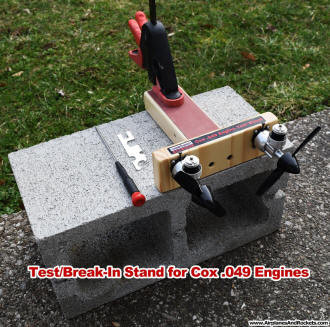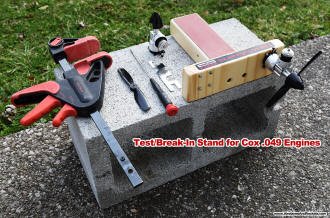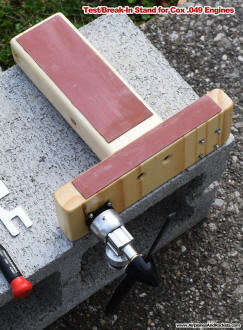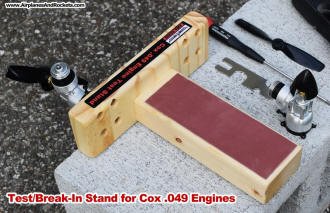|
 Sometime in the early 2000s I began making a transition
from glow fuel power to electric power. There was a general trend in that direction in the
modeling world, and there were certainly advantages in doing so. Lack of fuel mess, almost
no noise, and simple, reliable operation were the primary compelling reasons for adopting
the new paradigm in power plants. After all, technical advances in brushless motors, lithium
polymer (Li-Po) batteries, and electronics speed controllers (ESC) has reached - or nearly
reached - parity with internal combustion engines from a weight-to-thrust standpoint. Flight
times are still relatively short when using high power settings, but pilots have adjusted
to it. Sometime in the early 2000s I began making a transition
from glow fuel power to electric power. There was a general trend in that direction in the
modeling world, and there were certainly advantages in doing so. Lack of fuel mess, almost
no noise, and simple, reliable operation were the primary compelling reasons for adopting
the new paradigm in power plants. After all, technical advances in brushless motors, lithium
polymer (Li-Po) batteries, and electronics speed controllers (ESC) has reached - or nearly
reached - parity with internal combustion engines from a weight-to-thrust standpoint. Flight
times are still relatively short when using high power settings, but pilots have adjusted
to it.
Being an infrequent flier, keeping up with a good battery maintenance habit has been challenging;
that is, storing the Li-Pos at the proper voltage level and doing charge / discharge cycles
for a good shelf life. Most of the time, my battery packs end up bloating with gas after a
year or so, and that is with only a dozen or so flights on each pack per year. It gets expensive
replacing batteries with very little use, but using them with their propensity for spontaneously
catching fire is foolish. In fact, the whole explosion and fire issue is the main reason I
have decided to go back to glow fuel power.
 As anyone who visits the AirplanesAndRockets.com knows,
I spend a lot of time reading and documenting vintage model aviation magazines. Very, very
rarely, in multiple decades of publications, have I ever read of fires that involve glow fuel.
In fact, I don't recall any. There was one time when I was a teenager when my Fox .35 stunt
engine caught fire when it backfired while attempting to hand-start it - very weird. It was
mounted in a Sig Akrobat control line model. I was
able to blow it out easily, but it could have been a disaster. As anyone who visits the AirplanesAndRockets.com knows,
I spend a lot of time reading and documenting vintage model aviation magazines. Very, very
rarely, in multiple decades of publications, have I ever read of fires that involve glow fuel.
In fact, I don't recall any. There was one time when I was a teenager when my Fox .35 stunt
engine caught fire when it backfired while attempting to hand-start it - very weird. It was
mounted in a Sig Akrobat control line model. I was
able to blow it out easily, but it could have been a disaster.
The cost of glow fuel has skyrocketed in the last 10-15 years, probably because the demand
is drastically lower and therefore the efficiencies of mass production have been diminished.
Since my modeling budget is not high, I have elected to start with .049 power for my reentry
into glow power. 25% nitro glow fuel it necessary for easy starting and reliable running of
the small engines, so that does increase the unit cost, but the relatively low fuel burn rate
helps to offset the operational cost. Thanks to the new Cox International company in Canada, Cox engines are once again plentiful
and affordable.
 Remembering from past experiences that .049 engines
require a good break-in to run well, I invested a little time in building a convenient stand
to do so. I purchased four new engines from Cox International, with plans to use two of them
on a twin engined DC-3 control line model. Desiring to hear the uber-cool sound of a pair
of engines 'singing' in harmony even before having the DC-3 built, I designed the engine test
stand to hold two Cox .049s. Having never had a twin engine model airplane before, I was quite
surprised to experience the high vibration level when the engines are not running at very
nearly the same speed. It kind of scared me a little, but I'm hoping the cause is the two
engines being mounted on a common rigid platform with no opportunity for the structure to
absorb and dissipate part of the vibration of each individual engine. The propellers were
each carefully balanced and when running separately, both engines do not produce vibration
levels outside of the norm for an .049. Remembering from past experiences that .049 engines
require a good break-in to run well, I invested a little time in building a convenient stand
to do so. I purchased four new engines from Cox International, with plans to use two of them
on a twin engined DC-3 control line model. Desiring to hear the uber-cool sound of a pair
of engines 'singing' in harmony even before having the DC-3 built, I designed the engine test
stand to hold two Cox .049s. Having never had a twin engine model airplane before, I was quite
surprised to experience the high vibration level when the engines are not running at very
nearly the same speed. It kind of scared me a little, but I'm hoping the cause is the two
engines being mounted on a common rigid platform with no opportunity for the structure to
absorb and dissipate part of the vibration of each individual engine. The propellers were
each carefully balanced and when running separately, both engines do not produce vibration
levels outside of the norm for an .049.
 The engine break-in fixture is made of fairly soft
pine (or fir) from construction framing stock. A piece of 1/16" thick rubber is epoxied
to the bottom surfaces both to absorb vibration and to protect the bottom of the fixture.
2-56 blind nuts were mounted in countersunken holes for attaching the engines, figuring that
repeated use of wood screws would quickly result in stripped out holes. Squirting CA glue
into to pre-treaded holes for wood screw might have produced durable holes, but I didn't want
to take a chance. Four thin coast of clear lacquer were sprayed over the entire fixture for
fuelproofing. It sure is nice to hear those engines running again! The engine break-in fixture is made of fairly soft
pine (or fir) from construction framing stock. A piece of 1/16" thick rubber is epoxied
to the bottom surfaces both to absorb vibration and to protect the bottom of the fixture.
2-56 blind nuts were mounted in countersunken holes for attaching the engines, figuring that
repeated use of wood screws would quickly result in stripped out holes. Squirting CA glue
into to pre-treaded holes for wood screw might have produced durable holes, but I didn't want
to take a chance. Four thin coast of clear lacquer were sprayed over the entire fixture for
fuelproofing. It sure is nice to hear those engines running again!
To date, everything has worked out as planned. Only two of the four Cox .049 engines have
been run on the break-in fixture thus far. When time permits, I will begin the break-in on
the other two engines. I recently bought a Herr Engineering J-3 Cub that one of the .049s
will be mounted on. The aeroplane will use two channels (elevator and rudder) with the new
low cost Futaba 4YF,
4-channel, 2.4 GHz spread spectrum radio system, with Futaba S3114 Micro servos. A Hobbico
750 mAh, 4.8 V battery pack with AAA cells will be used for the airborne pack since
it is less that half the volume and weight of the standard NiCd packs with AA cells. The J-3
will eventually be featured in AirplanesAndRockets.com, so stay tuned...
Articles About Engines and Motors for Model Airplanes, Boats, and Cars:
Posted June 24, 2017
|